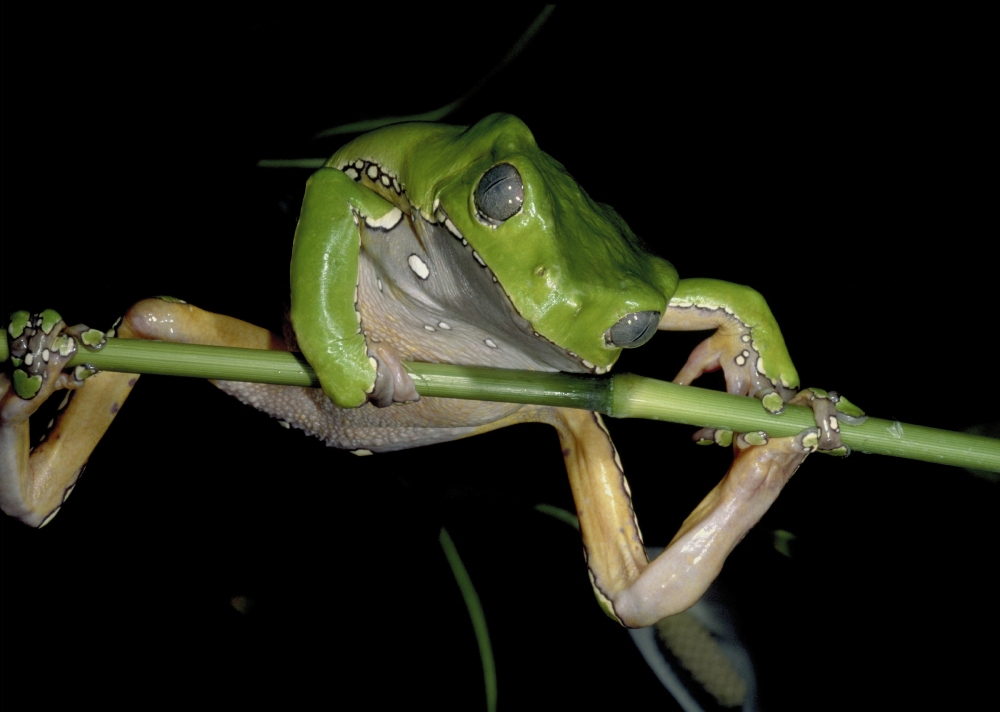Frogs Swallow Using Eyeballs: Exhibit Reveals Creatures' Quirks


NEW YORK — Neon green, vivid orange, striped and spotted — the frogs are back! An exhibit featuring live frogs from around the world is returning to the American Museum of Natural History here in New York.
The exhibition, entitled "Frogs: A Chorus of Colors," features more than 150 live frogs from approximately 25 species, from the brilliantly colored poison dart frog to the giant African bullfrog. The exhibit opens Saturday (May 18) and runs through Jan. 5, 2014.
"Frogs are so weird that although we might think we know frogs really well, there's just so much about their biology and what they do which is a chance in the exhibition to really surprise people," exhibit curator Christopher J. Raxworthy, a curator in the museum's department of herpetology and faculty member in its Richard Gilder graduate school, told LiveScience at a press preview of the exhibit.
The display introduces visitors to the biology and evolution of these wacky and wonderful amphibians, as well as their importance to ecosystems and the dangers they face. The colorful creatures, which were bred in captivity, peer through glass cases containing recreations of their natural habitats. [Image Gallery: Cute and Colorful Frogs]
Highlights include the pale-blue Mexican dumpy frog from the semiarid subtropical lowland forests in Mexico and the appropriately named tomato frog from the lowlands of Madagascar.
The frogs possess a certain mystique for visitors. People are drawn to the amphibians' bright colors and strange physiques. "I think that, aesthetically, it really gives people a high," Raxworthy said. In addition, there are the quirky things frogs do.
For example, many frogs swallow using their eyeballs. "Once they have prey in their mouth, to help force it down their throat, they actually pull their eyeballs down," Raxworthy said. And here’s another wacky tidbit: African clawed frogs were once used for pregnancy tests.
Get the world’s most fascinating discoveries delivered straight to your inbox.
The exhibit's centerpiece is a large poison-dart-frog vivarium containing more than 80 frogs, including bumblebee poison frogs, Bastimentos strawberry poison frogs and green-leg poison frogs. In the wild, poison dart frogs concentrate the toxins found in ants and other insects they eat into a powerful poison that the Emberá, the indigenous people of northwestern Columbia, rub onto darts for weapons.
Active research in the museum's department of herpetology is also featured in the exhibit. Biologists are still discovering new frog species. More than 6,000 species have been described so far, and that number is increasing rapidly, Raxworthy said.
Nonetheless, frog populations are dwindling around the world, and the exhibit features a short video about some of the threats frogs face. Nearly one-third of amphibians — 88 percent of which are frogs — are threatened, and at least 34 species of frogs (and possibly many more) are extinct. Habitat loss is a major cause, but a mysterious disease caused by the chytrid fungus is also to blame.
"There's lots we don't fully understand, but it’s very sad to see a big chunk of amphibian diversity now also suffering because of this disease," Raxworthy said.
The purpose of the exhibit is to educate people about these fascinating creatures, Raxworthy said. For visitors, he said, "This is a great chance to find out interesting facts about frogs you probably have no idea about. The more you dig, the more weird and wonderful it gets."
Follow Tanya Lewis on Twitter and Google+. Follow us @livescience, Facebook & Google+. Original article on LiveScience.com.



